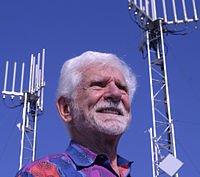The Birth of Mobile Communication: 1973 – The First Public Mobile Telephone Call
In the early 1970s, the concept of a mobile telephone was still a distant dream for most people. However, on the 3rd of April, 1973, Martin Cooper, a Motorola engineer, made history by placing the first public mobile telephone call on a Manhattan sidewalk. This groundbreaking moment not only marked the birth of the personal mobile communication era but also paved the way for the development of the cellular phone industry as we know it today.
Cooper’s invention, the prototype of the Motorola DynaTAC, was a bulky device compared to the sleek smartphones we use today. Nevertheless, its significance cannot be overstated. This historic call demonstrated the potential of mobile technology to revolutionize communication and connect people in ways previously unimaginable.
The Impact of the First Mobile Telephone Call
The first public mobile telephone call was a turning point in the history of communication. It challenged the notion that telephones were confined to homes, offices, or telephone booths. Suddenly, individuals had the freedom to make calls from anywhere, breaking free from the constraints of landlines.
Cooper’s call not only showcased the mobility of the device but also highlighted the possibilities for personal communication on the go. It opened up a world of opportunities for businesses, governments, and individuals, leading to the rapid growth of the cellular phone industry.
With the advent of mobile phones, communication became more accessible, convenient, and efficient. People could now stay connected while on the move, fostering a sense of connectivity and bridging distances. This new era of communication transformed how we interacted with one another and laid the foundation for the ubiquitous presence of smartphones in modern life.
The Evolution of Mobile Technology
Since that momentous call in 1973, mobile technology has come a long way. The early mobile phones were large, heavy, and had limited functionality. However, advancements in technology led to the development of smaller, more powerful devices.
In the 1980s, the first commercially available mobile phones hit the market, although they were still considered a luxury item due to their high cost. Over time, mobile phones became more affordable and accessible to the general public. The introduction of digital networks in the 1990s further revolutionized mobile communication, offering improved call quality and data transmission.
The early 2000s witnessed the rise of smartphones, which combined the functionality of a mobile phone with internet access, email, and various applications. These devices became an integral part of our daily lives, enabling us to stay connected, access information, and perform a wide range of tasks on the go.
The Future of Mobile Communication
The first public mobile telephone call in 1973 set the stage for continuous innovation in the field of mobile communication. Today, we are witnessing the emergence of 5G technology, promising faster speeds, lower latency, and enhanced connectivity.
With the advent of 5G, the possibilities for mobile communication are expanding even further. It is expected to revolutionize industries such as healthcare, transportation, and entertainment, enabling advancements such as remote surgeries, autonomous vehicles, and immersive virtual reality experiences.
As we look to the future, it is clear that mobile communication will continue to evolve and shape our lives. The first public mobile telephone call was just the beginning of a journey that has transformed how we connect and communicate. From the bulky prototype used by Martin Cooper to the sleek smartphones of today, mobile technology has become an indispensable part of our modern world.
References:
- History.com – First Public Cell Phone Call Made
- The Telegraph – The first mobile phone call: 40 years ago today
- Computerworld – The first call from a cell phone was made 40 years ago today

